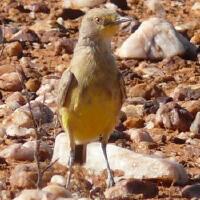|
|
|
|
|
|
|
|
|
|
|
[HBW - BirdLife (v3)] |
20/04/2024 02:08:42 AM |
|
|
| |
| Species Details [Taxonomy: HBW - BirdLife (v3)] |
|
|
| LC |
|
Gibberbird* |
Id (Atlas): |
452 |
| |
|
Ashbyia lovensis |
Endemic |
Description (10)

|
Gibberbird (Female)
© 2008 John Turner
|
|
|
|
Other Names (World)
Gibberbird, Desert Chat, Gibberchat, Bush-chat, Desert Bird, Gibber Chat
Family
Meliphagidae (Honeyeaters)
Size
12 - 13 cm
First Described (Guide)
(Ashby, 1911)
Derivation
Ashbyia - Edwin Ashby (1861 - 1941), ornithologist, SA: lovensis - Rev. J.R.B. Love (1889 - 1947), minister to aborigines in the interior
Abundance (Guide)
LC
Uncommon. Nomadic.
Habitat
Stoney, open, inland plains, with sparse dwarf bushes, grass-tufts. Bare earth in saltbush - bluebush.
Australia (B).
|
|
|
Inland eastern Australia, far southern Northern Territory, far western Queensland, far western New South Wales, north-eastern South Australia, south to about Quorn, west to the Stuart Highway. Vagrant to inland Western Australia.
|
| |
Rarity Status
Currently this species is not classified as a rarity in this country OR information has not been updated.
Population
Estimated population is unknown (2010).
Status LC
Probably secure.
For more information see BirdLife International Species Factsheet.
Habits
Singly or in pairs.
Food
Invertebrates, mainly insects. Sometimes also seeds.
Voice
A squeaky, 'dip dip'
 (28Kb) © ? (1) (28Kb) © ? (1)
|
Breeding Season (Guide)
June - December or after rain.
Nest
A cup, in a depression on the ground, lined with grass and twigs.
Eggs (Guide)
2 - 4; white, sometimes with a pink tinge, spotted olive-brown, red-brown and pale grey; oblong-oval; about 20 x 15 mm. Incubation: by both sexes, but mostly by female.
Young
Altricial, nidicolous. Fed by both parents.
Subspecies
No subspecies.
Similar Species
Female Orange Chat (Epthianura aurifrons) which is somewhat more yellow and has reddish-brown eyes.
Compare Images
References
See References.
The Field Guide to the Birds of Australia Pizzey, G., and Knight, E., 1997, Angus & Robertson, Sydney ISBN 0 207 19691 5
Field Guide to Australian Birds Morecombe, M., 2000, Steve Parish Publishing Pty Ltd. ISBN 1 876282 10 X
Field Guide to the Birds of Australia Simpson, K., and Day, N., 1999, 6th Edition, Viking ISBN 0 670 87918 5
Reader's Digest Complete Book of Australian Birds 1988, 2nd Edition, Reader's Digest ISBN 0 949819 99 9
What Bird is That? 1984, Revised Edition, Angus & Robertson, Sydney ISBN 0 207 14846 5
Handbook of Australian, New Zealand & Antarctic Birds 1990 - , Oxford University Press, Melbourne ISBN 0 19 553244 9
| More... see more information (images, calls, videos etc) |
Files:
 
BirdLife International
For more information about the Gibberbird see...  BirdLife International Species Factsheet. BirdLife International Species Factsheet.
Articles about the Gibberbird
If you would like to read any articles about the Gibberbird...  Show Articles (0) Show Articles (0)
No Pictures of Gibberbird
If Birdpedia has no pictures of Gibberbird or you would like to see more, then try the following...
 From BING (10) From BING (10)
No Videos of Gibberbird
If Birdpedia has no videos of Gibberbird or you would like to see more, then try the following..
 From BING (0) From BING (0)
Where can I observe this species?
On What Field Trips was this species observed?
Latest Sightings for Gibberbird
|
|
|
|
|